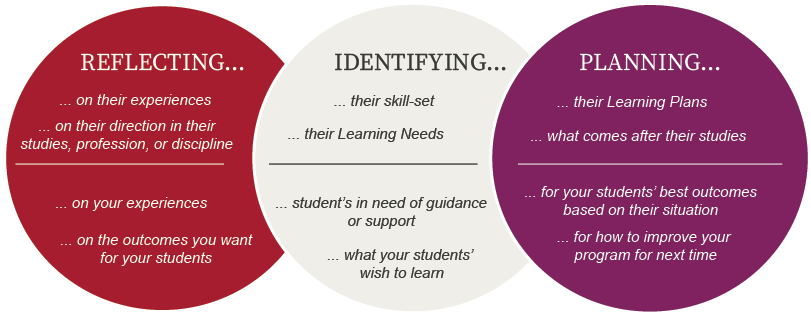What is Self-Guided Learning?
Self-Guided Learning - taking control of one’s own learning – is a method by which students take agency over their education. It requires independence, direction, and self-reflection, and in the best instances students of self-guided learning will develop a skillset for life, able to be employed across any number of careers, situations, and pursuits. Powered by autonomy and agency and the feeling of motivation that follows, self-guided learning can be employed in a wide variety of disciplines, from Maths to Nursing and Languages . One of the most common methods of initiating self-guided learning is having your students engage in critical self-reflection, from which, they can begin to identify what is important to them.
At the core of self-guided learning is a reflective practice which helps students identify what their personal goals are within the context of their unit of study, discipline, hobby, or profession. This might be as simple as personal everyday reflection or journaling, or through a more structured method such as SMART goals or a Competency model. This process gives your students a sense of ownership and agency over their learning journey, as their goals are their own (within the context of your unit or discipline).
Critical Self-Reflection
One of the most powerful elements of self-guided learning is the ability to critically self-reflect. It may seem simple, but the most common form of critical self-reflection is one your students already do – they reflect on their actions, and then make future actions or decisions based on how they approach a previous similar situation. In the classroom, you might like to offer a more structured exercise, to encourage students to self-reflect on a more critical level and provide them with a toolkit for future reflection.
As an act of personal reflection and self-direction, activities may sometimes be challenging or confronting for your students, but it is often rewarding. At their best, such activities can help your students begin to identify their goals and work towards them. Some potential activities include:
Initiating Self-Guided Learning
SMART Goals
SMART (Specific; Measurable; Achievable: Relevant; Time-Bound) Goals is a popular approach that offers students a structured tool for critical self-reflection and goal-oriented planning.
Here is a Smart Goals Template [.docx, 17KB] your students may find useful in helping think through and set their own goals, in and outside of their university life.
Learning Plans
Learning Plans are a powerful tool for self-guided learning. They combine critical self-reflection, goals-oriented thinking, and learner agency to give your student a powerful sense of direction in their education. At its core, a Learning Plan asks students to reflect on three questions:
What am I going to learn? How am I going to learn it? How am I going to know I have learnt it?
How your student answers these questions or chooses to progress through them is largely up to them, though you have the capacity to help guide and inform their goals in a mentoring capacity. Critically, self-guided learning commonly falls apart when the student or supervisor is not familiar or comfortable with the process and goals. Thus, your role in this process is to provide guidance to your students, and help them pursue their personal goals within the context of your program or unit.
Here is a Learning Plan Template [.docx, 17KB] for your students to use.
Ultimately, the power in self-guided learning comes from your students deciding what is important to them, and working towards those goals in a fashion that interests and drives them. The creation of a Learning Plan consists of three steps for both students and instructors: Reflecting, Identifying, Planning:

Contact the Faculty of Arts LD&P team to learn more, ask how you can start using Self-Guided Learning in your unit, and give your students agency over their studies.
Bibliography
Mira, K. (2023). A personalised autonomous model to resolve a prolonged dilemma in international students’ English language needs in higher education. Higher Education Research & Development, 42(3), 603-618. https://doi.org/10.1080/07294360.2022.2105823
Mira, K., Clifton, J. and A. Strutt. (2024). Enhancing English Language Proficiency and Well-being in EAL International PhD Students: The Impact of Personalised Autonomous Learning. Innovative Higher Education, 49, 271–298. https://doi.org/10.1007/s10755-023-09695-0
O'Shea, E. (2003). Self‐directed learning in nurse education: a review of the literature. Journal of Advanced Nursing, 43(1), 62-70. https://doi.org/10.1046/j.1365-2648.2003.02673.x
Pape, S. J., Bell, C. V., & Yetkin, İ. E. (2003). Developing Mathematical Thinking and Self-Regulated Learning: A Teaching Experiment in a Seventh-Grade Mathematics Classroom. Educational Studies in Mathematics, 53(3), 179–202. http://www.jstor.org/stable/3483340
Pintrich, P. R. (2004). A Conceptual Framework for Assessing Motivation and Self-Regulated Learning in College Students. Educational Psychology Review, 16(4), 385–407. http://www.jstor.org/stable/23363878
Rose, E (2013). 'Why does reflection matter?', On Reflection : An Essay on Technology, Education, and the Status of Thought in the 21st Century. Canadian Scholar’s Press, 17-35.
